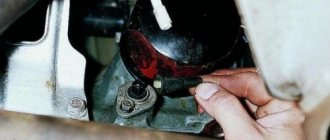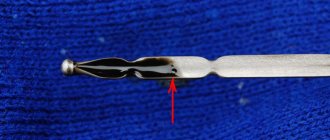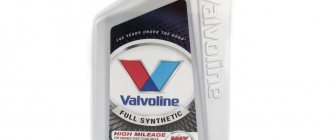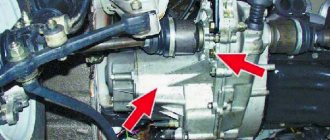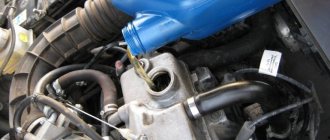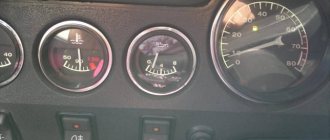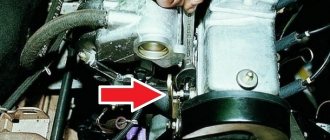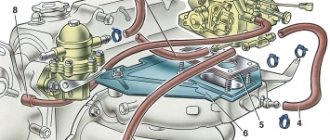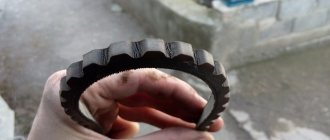After starting the engine of a VAZ 2108, 2109, 21099 car, the oil pressure warning lamp on the instrument panel lights up, or when the car is moving, the pressure lamp lights up suddenly. The reasons for this situation in the operation of a carburetor engine are both a malfunction of the engine itself and a malfunction of electrical equipment.
The engine oil pressure indicator light is on (reasons)
1. The tip of the wire fell off the output of the oil pressure sensor in the cylinder head.
Check if this is true and fix the problem.
2. The engine oil pressure sensor itself is faulty, or its electrical circuit is faulty.
Turn on the ignition, remove the wire from the oil pressure sensor and touch it to the vehicle ground (engine, body...). If the light goes out, the sensor is faulty; if not, its electrical circuit is faulty. Or, for greater accuracy, check the pressure in the lubrication system using a pressure gauge.
3. Low oil level in the engine crankcase.
Let the engine sit for 15 minutes, then check the level by pulling out the dipstick. Add oil if necessary.
4. Low engine idle speed.
When the crankshaft speed drops below 650 rpm, the oil pressure warning light may blink or clearly illuminate. Adjust idle speed. The norm is 750-850 rpm.
5. Engine oil pump is faulty.
6. Engine oil filter is faulty.
7. The oil intake of the oil pump in the engine sump is dirty.
Remove the pan and clean the oil intake.
Five more articles on the site on VAZ car engines
The owner of the Nine will most likely find out that there is a VAZ 2109 oil pressure sensor and an oil level sensor in the engine compartment when the indicator on the instrument panel lights up red, indicating that there are problems with the oil pressure level. And then many questions immediately arise, including what kind of oil should be poured into the system, whether its volume is sufficient, but most importantly, whether this small device has deteriorated. Let's take a closer look at what an oil pressure controller is, what its operating principle is, and how accurately its performance can be determined.
When the engine heats up, the oil pressure lights up: consequences for the engine
Let's start with the fact that any problems with lubricant pressure mean that the power unit is experiencing oil starvation. Simply put, the rubbing surfaces do not receive enough motor oil and their wear begins to increase. Oil also plays the role of a cleaner and cooler, washing away wear products and lowering the temperature in the area where the surfaces of rubbing pairs work.
Also, when the efficiency of the oil system decreases, knocks and noises appear in the engine, which subsequently lead to more serious damage or even engine seizure. In this case, jamming may well be accompanied by a “fist of friendship,” which greatly complicates the repair of the damaged unit and increases the overall costs of restoring the internal combustion engine.
Consequences of ignoring the problem
Stopping the engine when the pressure lamp lights up is a mandatory measure. Ignoring the signal can result in very serious problems:
- As a result of “oil starvation”, the contacting surfaces of components and mechanisms will begin to work “dry”, which will lead to their intense wear and high heating. If you take a crankshaft, the main and connecting rod bearings will begin to melt and “wrap” around the journals, which will lead to jamming of the crankshaft;
- Lack of lubrication will lead to intense wear of the camshaft “bed”;
- Wear products - small metal shavings - will spread through the channels of the lubrication system, which can lead to their clogging. Also, chips can cause jamming of the pressure relief valve and damage to the oil pump gears.
Elimination of such malfunctions is only possible through a major overhaul of the power plant.
Oil pump
A gear pump with an oil receiver and a pressure reducing valve in the cover is installed in the engine crankcase. The pump is attached to the cylinder block with two bolts.
Gears are installed in the pump housing: the drive gear is stationary on the pump shaft and the driven gear is free on an axis pressed into the housing. The pump is driven by a chain transmission from the crankshaft sprocket to the auxiliary drive shaft sprocket, which is installed in the cylinder block in steel-aluminum bushings. The roller has a helical gear that meshes with the drive gear of the oil pump and ignition distributor, which rotates in a cermet bushing. On the latest car models, the drive shaft of auxiliary units is also installed in metal-ceramic bushings.
Recommendations
Comments 13
thanks, fixed the problem. The problem is that the oil pressure sensor did not work. Where the timing belt cover is located nearby, the wire from the oil pressure sensor broke. I took a piece of wire about half a meter, soldered it, soldered the terminal again, and connected it to the sensor. I connected the battery terminal, turned the key and STOP and OIL lights up on the dashboard. Thanks for the advice and for the picture of the diagrams
Well, I roughly described the problems to you. If you need a book by email, I’ll send it to you in PDF format, you need Adobe Reader to open it.
ok, send me the book... just in case
Hello. I have the same problem, I have a VAZ 21083, with a low instrument panel, when I turn the key with one push (the stop light does not light, the oil light does not light up), the battery lights up. How to fix the problem? can you help me suggest a diagram? I changed all the light bulbs to new ones, treated them with a bucket, same problem. Thank you
Was everything on fire before? If yes, then look first at connecting the wire to the oil pressure sensor on the engine. A possible second option in this case may be that fuse F16 (15A) has blown in the mounting block from the VAZ-2114 (2115) or No. 5 (8A) in the old VAZ Fuse Box, but the following devices will not work: Turn indicators and relays turn signal and hazard warning light switch (in turn signal mode). Turn signal indicator lamp. Rear lights (reversing lamps). Gearmotor and windshield wiper activation relay. Generator excitation winding (when starting the engine). Indicator lamp for low brake fluid level. Oil pressure drop warning lamp. Carburetor air damper warning lamp. Indicator lamp for turning on the parking brake. "STOP" light display lamp. Coolant temperature gauge. Fuel level indicator with reserve indicator lamp. Voltmeter. Well, if all the devices listed above work, except for the control lamps you listed, then look at the wire connections on the block suitable for the instrument panel and at the output from the safety block. And the best option is to find a good electrician, even if you have to pay money. If you have an email, write the address and I’ll send you the wiring diagrams from number nine.
There were no problems with the electrics before, everything worked perfectly. everything works except stop and engine oil pressure. The entire fuse box is working, the fuses are intact and not blown, recently replaced with new ones. The relay also works. There seems to be something wrong with the instrument panel. I disconnected the cable from the engine, then from the dashboard, cleaned it, treated it with a bucket, and replaced the lamps. I tried to insert the key into the ignition, and turned it over with one push. does not burn. ok I'll give you my email. thanks for the advice. I'll contact an electrician. thanks for the advice. I'll try to figure it out. I have an old-style eight, low panel
Thanks for the response, I removed it and found a burnt track there, a broken wire, it was all oxidized. I cleaned everything, I haven’t soldered it yet. I think that was the problem after all!)
hi, how do I understand (additional leg) I’m new to this business, my Akum lamp is constantly on, although it charges everything normally, and when I pull out the handbrake, my brake light comes on and the brake fluid level lights up, what a joke, how do I remove it in a VAZ 2108 low ponel?
I thought about my problem for a very long time, because when I turned on the ignition, instead of the battery, the indicator for closing the throttle air damper came on. In the 4th photo, an additional leg is clearly visible (it is screwed to the board with a bolt). There was also a problem with suction, when the handle was pulled out the low brake level indicator came on - this problem was solved by rearranging the wires, but before that I smoked electrical circuits from the VAZ-2109 for a very long time, everything was solved by the so-called poke method. There is also a problem with the emergency lights and the handbrake lights up instead of a triangle. It is possible that the wires in the terminal blocks are mixed up, this could be if the wiring or instrument panel was changed in the car (there may be different circuit boards on the instrument panels). For example, I have Hungarian, maybe the USSR or some other country. But the surest option is to find a competent electrician. Good luck on the roads and in solving your problem.
I bought the car already with such a tidy. So try searching on the Internet. On the ProSport website I saw tens and fourteens. You can also look at the Tuningsport website.
Where can I buy such an overlay?
Which one? On a low panel or on instruments?
EMERGENCY MEASURES
So, the oil pressure light on the dashboard came on while driving. As already noted, you should immediately stop and turn off the engine. Since while on the road there is no way to accurately determine the cause of the problem, the only diagnostic method is a visual inspection.
After stopping the engine:
Depending on the results of the inspection and level check, we take further actions. If a slight leak is detected, and the dipstick shows the amount of lubricant below o, you can continue moving to the repair site, but first replenish the oil loss and check whether the warning lamp lights up. To top up, you should use the same lubricant that was filled in (it is not for nothing that it is recommended to always carry oil with you for topping up) or purchase a similar one. During the movement, you should stop periodically and replenish the level.
We do the same in the case when no leaks are detected, but the level is below normal. We just add lubricant, make sure that the control light does not light up and continue on our way, periodically stopping and checking the dipstick. If there are no leaks and the oil level is normal, it is possible that the pressure sensor is acting up. Restarting the engine after a short pause (the time it will take to inspect the engine and assess the amount of lubricant) will help verify this.
If the lamp lights up even when you restart it, it is better not to experiment, but to call for help to transport the car to the repair site. It is strictly forbidden to operate the machine if the dipstick shows a level higher than normal or if there is a foamy whitish coating on it - emulsion (you can additionally check for the presence of emulsion on the oil filler cap).
This indicates that other technical fluids, such as antifreeze or fuel, are leaking into the pan. An excessive level of oil (liquid mixture) in the pan has a strong negative effect, as does its lack.
The problem is diagnosed by the non-characteristic color of engine oil and smoke from the exhaust pipe.
These are all the measures that can be taken in an emergency situation - when the lamp lights up while driving and there is no necessary equipment and tools for a more detailed search for the cause.
When might the warning light come on?
The oil pressure in the engine can drop for various reasons, some of them are insignificant and do not cause harm to the engine, while others, on the contrary, can cause serious damage to the power plant, which can only be eliminated by carrying out a major overhaul.
Therefore, the lighting of a special warning lamp is a serious reason to start looking for the cause.
The oil pressure light can come on in a variety of situations, starting with the fact that it simply does not go out after starting the engine and glowing while driving.
This problem can appear both “hot” and “cold”, at medium loads and at idle, as well as after a planned replacement of the lubricant (especially when switching to a new brand of oil).
When the pressure warning light comes on, this is not a situation where “I’ll just get home and see.” When such a signal appears, measures should be taken immediately.
The first thing to do is to immediately turn off the engine and stop driving. And then look for the cause on the spot or organize delivery of the car to the repair site (by tug, tow truck).
Note that sometimes failures in the sensor occur, so as one of the first measures you should wait 3-5 minutes and start the engine again and let it run in different modes.
If the sensor is “silent”, you can try to continue driving, but it is better not to leave the problem unattended and, if possible, check the components of the lubrication system. If the lamp comes on when the engine is restarted, the car will have to be towed.
How to check oil pressure?
While operating the vehicle, you will be required to check the oil pressure. This procedure is as important as checking the oil level. Every motorist should have a set of necessary devices, but for this operation you will need a pressure gauge.
Where is the oil pressure sensor located?
You should look for it under the decorative trim of the black engine. Checking oil pressure:
1) It is necessary to warm up the engine to the standard operating condition of 90 degrees;
2) Turn off the engine;
3) Open the hood and find the emergency oil pressure sensor;
4) Disconnect the sensor;
5) It is necessary to attach the tip of the pressure gauge to the vacated hole;
6) Start the engine;
7) Depress the gas pedal to 5400 rpm and observe the oil pressure.
What oil pressure should be in the engine?
At minimum speed it should show at least 196.2 kPa (2 bar), and at maximum - 441.3-637.5 kPa (4.5-6.5 bar). Low pressure indicates a major overhaul of the engine, and high pressure indicates a breakdown of the safety or pressure reducer oil pump valve.
Is the oil pressure warning light on or flashing?
If it flashes or lights up on empty, then several reasons can be noted:
1) Suitable oil level;
2) the oil does not correspond to the vehicle parameters;
3) failure of the emergency oil pressure sensor;
4) failure or malfunction of the oil pump.
Very often, problems with oil pressure occur in older cars due to their natural wear and tear and wear of the oil pump. But there are also problems with new cars that have been in an accident, resulting in engine damage.
Sensor diagnostics
Electronic and mechanical oil pressure sensors are checked in different ways, so we will consider each of them separately.
But before you start checking, it is important to make sure that it is the DDM that is the root cause of the warning light that does not go out.
First, make sure that the oil is in good condition and that its level in the engine is within normal limits. Is the filter clogged because the fluid in the system was changed a long time ago? Make sure the pump is working properly.
IMPORTANT: check the wiring from the sensor to the ECU, the condition and integrity of the contacts.
Next, find and remove the sensor itself. This must be done with the engine turned off. Preferably cooled. On different cars the unit may be located in different places.
Loss of oil pressure when the VAZ engine is hot
- Registration
- Entrance
- To the beginning of the forum
- Forum Rules
- Old design
- FAQ
- Search
- Users
Hello. Tell me what could be the problem? Engine VAZ 21124, after repair. Oil pressure drops when the engine warms up. On a cold engine, at idle, the oil pressure shows more than 3 (I don’t know exactly how much, the device is homemade and the scale only goes up to 3), well, when the engine starts, it goes off scale. As the engine warms up. the pressure drops when fully warmed up at idle, it shows 0.5, if you accelerate it with difficulty it reaches 2. I tried to measure it with two factory pressure gauges in the service center, and when it’s hot it’s also 0.5. My pressure gauge showed on another car, where the engine was in perfect condition, 2 on a warm engine, at xx.
We assembled the engine ourselves. The block was bored out for the first repair, everything was washed and blown out with compressed air, the piston is new, the elbow was measured by a turner, it is in good condition, the liners are new, the oil pump is new, visually there are no oil leaks anywhere, it works and starts well, the hydraulic valves do not knock, the traction is good.
I tried to do the following: I removed the oil receiver - it was clean, checked the main liners - there was no wear and tear, removed the oil pump pressure reducing valve (bent the spring a little), re-glued the camshaft pastel with red sealant. All this did not give any results, only after re-gluing the pastel, when heating one hydraulic compensator began to knock, the pressure did not change. Tell me, what else could it be? Thank you in advance.
Lack of oil
So, one of the most common reasons for a signal from a pressure sensor is insufficient amount of oil in the engine. This is usually manifested by the light of the lamp at idle.
Due to low engine speeds, the pump is simply not able to supply oil to all rubbing surfaces due to its lack.
As the speed increases and as the lubricant warms up, it begins to circulate faster and the pressure in the system increases, to which the sensor reacts and the lamp goes out.
Reducing the amount of lubricant is a common phenomenon. Among motorists, this phenomenon is called “the engine takes oil.” It is inherent in all engines, both new and worn.
An engine in a car with no mileage, or one that has been overhauled, consumes a small amount of lubricant and this is almost imperceptible. A worn-out power unit can “take oil” in considerable quantities - up to 1 liter for every 1 thousand km.
Therefore, when the oil pressure control lights up, first of all we stop the engine, inspect it for lubricant leaks, wait a while for the glass to lubricate into the pan (usually 2 minutes), and then measure the level.
If necessary, adjust the amount of oil to the level, and then start the engine and make sure that the control goes out.
If there is no liquid on hand to top up, the car should not be operated under any circumstances.
Sensor, filter.
The second, no less common problem is the failure of the sensor itself. This also happens, and he begins to “live his own life,” closing and opening contacts for no reason. In this case, the lamp lights up in any mode, without any systematicity.
The simplest way to check it is to sharply increase the speed to 4-5 thousand, while the amount of lubricant should be normal.
If the lamp does not go out at such speeds, the problem is solved by replacing the control sensor.
The lamp may also light up when using a fake oil filter. The fact is that this element should always contain a small amount of oil. Even if the engine is not running.
When starting the engine, this oil will ensure rapid filling of the oil channels, which will contribute to a faster increase in pressure to the required value.
In fake filters, the lubricant often does not remain, but completely flows into the pan. This causes the pump to take longer to build up pressure. This problem can be eliminated by simply replacing the filter with a high-quality one.
Looking for a fault
Until the cause of the oil pressure light coming on is eliminated, it is better not to operate the car. To solve the problem, you can contact a service center, or identify and fix the problem yourself, saving on service station services. Much depends on the make of the car.
If there are no visible causes of the problem - there are no leaks, and the level is normal, we carry out diagnostics.
Self-testing is carried out “from simple to complex.” The main working element of the system is the lubricant. Therefore, we check it first.
If the lubricant is not changed on time (every 8-10 thousand km), perhaps the oil has exhausted its resource and has become very liquid, which is why the oil pump is not able to pump it in the required quantity, creating the necessary pressure.
In cases where the lubricant has been changed relatively recently, make sure that the tolerance and specification of the engine oil that was filled in matches the car’s engine.
Next, we move on to the next stage of testing - measuring the pressure in the system.
Sensor design and operating pressure check
To determine whether a device is functional, you need to understand how it works. It is also useful to know how the controller and the VAZ engine, or rather its lubrication system, interact with each other. The sensor is mounted on the cylinder head on the side on which the carburetor is located. Next to the controller there is a VAZ oil filter.
The design of the oil pressure controller is very simple. It consists of a housing, a built-in control and measuring elastic membrane and a transmission mechanism. The principle of operation of the device in question is also quite simple. Engine oil for VAZ, located in the lubrication system, acts on the membrane during engine operation.
The latter is deformed by an amount corresponding to the oil pressure. Vibrations of the elastic “partition”, which make or break the contacts of the electrical circuit, are transmitted to the rheostat through the mechanism mentioned above. In turn, changing the resistance of the rheostat affects the indicator readings on the car’s dashboard.
Checking the operating oil pressure using the crankshaft is used, as a rule, in cases where the indicator begins to signal a drop in pressure in the lubrication system away from the service station, and the driver does not have a pressure gauge at hand.
Before checking, you must make sure that the oil level in the system and the corresponding VAZ 2109 filter are in order. If the level is insufficient, the oil will have to be filled to the nominal level. Then you can proceed directly to checking the health of the sensor. For this purpose, it is unscrewed from the socket.
https://youtube.com/watch?v=PDAXIp_WN6Y
With the lubrication system open, the crankshaft of the machine is turned manually (without turning on the engine). If at the same time the hole into which the oil pressure controller was screwed begins to fill, then the pressure is normal. The indicator that continues to light indicates that the sensor has failed.
In this case, the device should be carefully inspected for defects. If there is no damage, it must be washed with gasoline (diesel) and installed in its original place. If the light continues to light after this, the sensor will have to be replaced.
Important information about the oil level sensor
The health of the engine can be judged by various signs. One of them is the oil level. If oil consumption has increased, this means that there are some problems in the system that need to be corrected.
Purpose and location
The main purpose of the oil level regulator is to control the lubricant level so that the mechanisms and components of the engine function normally.
The VAZ 2109 oil level controller is located between the oil filter and the oil pan at the bottom of the engine. It is inserted into the hole intended for it in the power unit housing.
Oil pump drive
The oil pump drive is a part that needs to be discussed separately. The fact is that the duration of operation of the entire motor depends on it. The drive part of the oil pump itself consists of several parts:
- parasitic shaft;
- intermediate gear;
- small shaft;
- big shaft
The drive is considered a simple part of the pump, but the gear splines quickly wear out during operation.
Most cases of oil pump failure are associated with a breakdown of the drive, or more precisely, with wear of the gear splines. Most often, the splines “lick off” when starting the car in winter; in this case, the engine cannot be started again.
Gear wear is an irreversible process during long-term operation of the machine. If the gear teeth begin to slip, the pressure in the oil system will be below operating pressure. Accordingly, the engine will not receive the amount of lubricant that it needs for normal operation.
How to replace the pump drive
Replacing the drive gear is not an easy procedure, but after careful preparation, you can remove the drive and repair it:
- Remove the car's ignition distributor.
- To remove the intermediate gear, you will need a special puller. However, you can get by with a simple wooden stick with a diameter of about 9–10 mm. The stick needs to be hammered into the gear and then rotated clockwise. The gear will then easily come out.
- Install a new one in place of the worn gear using a regular stick.
- Replace the ignition distributor.
Video: replacing the oil pump drive mechanism
What is a “hog” and where is it located?
The VAZ 2106 mechanisms include a shaft, which is called the “hog” (or “pig”). The shaft itself drives the car's oil pump, as well as the gasoline pump and sensors. Therefore, if the “hog” suddenly fails, then the machine ceases to function normally.
The intermediate shaft is located in the engine compartment of the VAZ 2106 on the front side of the cylinder block. On the “six” the “hog” is started using a chain drive. This shaft has an extremely simple structure - only two necks. However, if the bushings on the journals are heavily worn, the operation of the oil pump and other mechanisms will be difficult. Therefore, when checking the pump, they usually look at the operation of the “hog”.
The shaft, called the “hog”, is mounted in front of the cylinder head
You can work with the oil pump on the VAZ 2106 yourself in the garage. The main feature of domestic “sixes” is precisely their unpretentious maintenance and simplicity of design. You can repair the oil pump and adjust the pressure in the system yourself, since there are no special requirements for this procedure.
Possible reasons for VAZ 2106, 2108, ZMZ 406, 405
But there are also reasons that may appear on specific cars, since there is another factor that influences the occurrence of the problem - the design features of the engine.
For example, on carburetor engines of the same VAZ-2106 or 2108, fuel can penetrate into the sump through the fuel pump. This unit on such engines is mechanically driven by a timing belt.
And due to damage to the pump membranes, fuel will penetrate inside the engine and mix with the oil, diluting it and increasing the level.
But on the ZMZ-406 engine, the cause of the pressure drop, in addition to those described, may be damage to the oil pump drive. Because of this, the unit simply will not function normally, which will affect the performance of the lubrication system.
Mechanical breakdowns inside the engine should not be discounted, as a result of which the operation of the lubrication system is affected. For example, a break in the timing chain tensioner shoe, for example, on the same VAZ-2106, will lead to the torn part starting to hit adjacent surfaces, knocking out small pieces of metal.
The chips formed as a result of such a breakdown will enter the lubrication system, and then settle in the filter, leading to a drop in pressure in it.
Or on the same ZMZ-405, the pump is driven through an intermediate shaft, which is driven by a timing chain. If the sprocket of this shaft breaks (it can rotate separately from it), the pump will stop working.
And there are enough such nuances. But in any case, without eliminating the cause of the malfunction, you should not use the car, so as not to end up with expensive repairs later.
We recommend watching:
- How much does the body of a Cossack weigh?
- VAZ 21103 oil pressure victory
- Installation of connecting rod bearings VAZ 2106
- I checked the inserts, what is it?
- What does it mean to turn the liners in the engine?
- Oil pressure reducing valve VAZ 2112
Checking the lubrication system components
If replacing the sensor and ringing the wiring did not bring any results, and the lamp still works, you should look for the cause further.
The next steps are:
- REPLACE THE OIL FILTER. This element is equipped with a bypass valve and if this valve does not work, then after starting the engine the system needs time to pump oil (this problem manifests itself in the form of a constantly burning light after starting). Another problem associated with the filter is its severe clogging, which is why it creates a strong obstacle to the movement of oil, preventing it from rising to the cylinder head where the sensor is installed;
- REMOVE THE PAN AND INSPECTION THE OIL PICKUP. Over time, the intake mesh becomes clogged with various deposits (this is especially true with frequent changes of oil brands and the use of additives). Due to deposits, it is difficult for the pump to “pull” the required amount of working fluid from the pan, so the pressure will be insufficient;
- CHECKING THE OIL PUMP. Backlash and wear marks on the gears will indicate severe wear. Due to the gaps, the unit is simply not able to pump oil and a loss of pressure occurs;
- WE ASSESS THE CONDITION OF THE REDUCTION VALVE. This element is designed to relieve pressure when a certain value is exceeded. But if the valve gets stuck in the open position, it will leak oil, preventing the pump from pumping up the required pressure.
These indicate the causes of pressure drop associated with the lubrication system.
Oil pump on VAZ cars, operating principle and main malfunctions
Kamaz pump
The device that supplies oil to all components and assemblies of the engine is called an oil pump.
The life of the internal combustion engine as a whole depends on the correct operation of the oil pump, so it is very important to ensure that the operation of this unit is at the proper level. At the slightest sign of a malfunction in the oil pump, it is necessary to repair it, since if you do not pay attention to this problem, there is a high risk of engine seizure. The VAZ oil pump has two types of device: one type is typical for all front-wheel drive cars (the VAZ 2109, 2110, 2112 oil pump has an almost identical design), and the other type is typical for both classics and the Niva model
If we talk about the principle of operation of the oil pump, then on front-wheel drive cars it is driven directly from the crankshaft, but on classics the system is more complicated. For example, the VAZ 2106 oil pump is driven using a chain drive
The VAZ oil pump has two types of device: one type is typical for all front-wheel drive cars (the oil pump VAZ 2109, 2110, 2112 have an almost identical design), and the other type, typical for both classics and the Niva model. If we talk about the principle of operation of the oil pump, then on front-wheel drive cars it is driven directly from the crankshaft, but on classics the system is more complicated. For example, the VAZ 2106 oil pump is driven using a chain drive.
Having understood the differences, let's talk about the technical part.
The device of the oil pump on VAZ cars
So, the oil pump consists of a housing, an oil receiver, a drive and driven gear, an oil pump pressure reducing valve and other small elements, such as an oil pump gasket, oil seal, etc.
Consequently, given the design of the oil pump on domestic cars, the weak points are the oil seal and the oil receiver. As a result of using low-quality oil, the receiver grid quickly becomes clogged and the oil pressure in the engine system drops. The oil pump itself has a service life of 120–150 thousand km, but sometimes certain problems occur that may require repair or replacement of the oil pump. Of course, replacing the oil pump on a VAZ 2109, or on any other model, is a complex and costly procedure, so it is better to carefully monitor its correct operation and, if necessary, arrange for preventive maintenance in the form of more frequent oil changes.
In addition, periodic checks of the oil pump will not be superfluous.
How to check the oil pump?
The first and main sign of a malfunction in the oil pump will be a warning light that comes on, but it already indicates the presence of a serious malfunction. In order to check the correct operation of the oil pump, it is not at all necessary to remove it, as some experts advise. It is enough just to measure the engine oil pressure and compare it with the indicators that are considered normal for your car. Having received the number, you can already know what to do next - use the car with peace of mind, or prepare for repairs.
When replacing or repairing the oil pump of a VAZ 2109, 2110, and even 2106, be sure to use only original spare parts. The problem is that for domestic cars there is a large selection of parts from various manufacturers, and, as a rule, the bulk of these parts are of very low quality.
- Repairing a muffler with your own hands If the “X” day has come in your life, when the car stopped purring like a kitten and roared like a hungry bear, do not rush to look for options for an old, burnt-out muffler, because it is quite possible that you can improve the situation with the help of repairs that , besides, you can also make your own...
- Adjusting headlights with your own hands It is believed that adjusting car headlights can only be done at a specialized service center that has the necessary equipment, stands, etc. Of course, this is preferable, but no one ruled out the possibility of adjusting the headlights with their own hands, because most of us do just that...
- Flushing diesel injectors One of the most common problems with a diesel engine is a malfunction of the fuel injectors. The design features of a diesel engine, low-quality fuel - all this eventually leads to problems associated with injectors. The engine begins to operate unstably, fuel consumption increases, the engine starts reluctantly, and puffs of black smoke come out of the exhaust pipe. All …
Design
Oil pump VAZ 2109
Today there are three types of pumps:
- 2-gear pumps, in which one gear is connected to a shaft, which starts working from the intermediate or camshaft of the VAZ. This pump is installed inside a sump located in the lower area of the cylinder block. Typically, the rotation speed of the element is ½ the rotation speed of the motor.
- A gerotor pump has a rotating small gear inside an outer gear. This pump is located in the lower area of the motor in the sump.
Old style oil pump
The internal pump is often installed on the front cover of the engine. It begins to function from the crankshaft. Structurally, such a mechanism is similar to a gerotor mechanism, but in this situation it replaces the front damper of the engine. As a result, it is possible to generate higher oil flow with higher pressure.
Another factor is winter.
The season of operation of the car can also affect the lubrication system. In winter, in severe frosts, the oil can harden so much that the first time after starting the engine the pump is not able to pump it in the required quantity. Preheating the pan before starting the engine can eliminate this problem.
Another reason for the pressure lamp to light up after starting the engine in winter is condensation. Due to temperature changes, moisture accumulates inside the engine, which then settles and freezes on internal surfaces, including the oil intake screen and oil channels. In this case, letting the car sit in a heated place will help - after the engine heats up, the condensate will melt and drain into the pan.
Note that the above describes the general causes of a drop in engine oil pressure, which are typical for any car - VAZ-2109, 2101, Priora, Niva, 2110, 2114, etc.
What should the engine oil pressure be?
There is no uniform standard for engine oil pressure, and the reason is simple: the design of motor systems from different car manufacturers has some differences. But even here there is one general rule: the oil pressure at idle speed on the engine cannot be higher than in load mode. The fact is that the faster the system elements rotate, the more lubrication they require.
To understand what the indicator we are interested in should be, it is necessary to imagine the principle of its measurement. Modern cars are equipped with special sensors - they monitor the condition of the oil in the system. Unfortunately, they are not accurate in all cases, but a triggered sensor can both save money on repairs and save lives. And if repairs are still required, it will cost a lot.
The operating manual for the vehicle indicates the main technical characteristics and operating modes of the lubricant. You can also usually find brands of fluids that are best suited for a particular engine. By the way, manufacturers offer branded oil under the brand of automakers.
You can find indicators that are considered normal in the repair and operation manual for your car.
So, for the famous Russian car “Lada Priora” at idle the norm is 196.2 kPa, that is, about 2 bar, and at 5,400 rpm the norm is 4.5–6.5 bar. This level is considered the maximum for the car.
Manufacturers of American brands usually write normal pressure per 1,000 rpm. At 1,000 rpm the average is 10 psi (or 67 kPa). For example, at 2,000 rpm the norm is 1.3 bar, and at 5,000 rpm the figure increases to 3.4 bar. But when assessing these indicators, we should not forget about the difference between domestic cars and foreign cars, as well as the differences in operating conditions.
The level of normal oil pressure in the engine is influenced by many factors:
- engine displacement;
- number of cylinders;
- number of valves per cylinder (2–4) in the timing system;
- volume of oil poured at a time;
- turbocharged internal combustion engine or naturally aspirated;
- gasoline or diesel engine;
- in-line, V (W) shaped, opposed arrangement of cylinders.
For example, for a VAZ-2106, the minimum oil pressure at engine idle speed is 0.2 bar - it can be tracked using the arrow on the panel. If the level is insufficient, the red indicator on the panel lights up. On older models it looks like a red lamp, on new ones it is a watering can icon. For a VAZ-2106, the oil pressure on a warm engine at speeds up to 4,500 per minute should be about 4-5 bar. In other words, the pressure increases in direct proportion to the increase in speed.
But you need to understand that if your car runs on a diesel engine, the picture will be different. Let's look at this using the example of a Mercedes Benz Vito with engine 611980. For this 2.2 liter unit, the oil pressure in a diesel engine is considered to be 0.3 bar at idle speed. In the area of the green scale, this figure rises to 3–3.5; if the value is too low, you should make sure that the car’s lubrication system is working properly.
If we consider ZMZ motors, the situation here is not much different. For the 405 engine, 0.4 bar at idle and 4 at high speeds (2 or more) are considered normal. Previously, all the necessary data could be obtained thanks to the arrow indicator, but now, after the release of GAZelle Business, they are displayed by the on-board computer on the dashboard, and with an accuracy of hundredths.
In the Chevrolet Lacetti 1.4 engine, the minimum DM level is 0.6 bar at idle, while at 3,000–3,5000 the oil pressure on a hot engine rises to 3 bar.
Today, the most productive pumps are equipped with VAZ models, namely the Lada Priora and VAZ 2110 with a 16-valve engine. Therefore, at idle the DM does not rise above 1 bar, and at 5,000 the needle reaches 6–6.5.
In the case of the Renault Logan, everything is different: for engines with an 8-valve timing belt, the normal value is 0.3 bar at idle. Whereas for 16-valve engines this level is twice as high.
An increase or decrease in DM relative to factory standards has a negative impact on engine performance. An insufficient indicator provokes oil starvation, which increases friction between the elements of the system, and this leads to their rapid wear and may even cause the engine to jam. Too high a level breaks the tightness of the connections, which causes leaks of seals and gaskets, and squeezing out of the seals.
Third-party liquids in the pan
As for the increased oil level, it is not necessary to check the lubrication system, since the reason for the lamp to operate is the ingress of technical fluids into the pan. And here it is necessary to establish where they are leaking from and eliminate the damage.
If instead of oil an emulsion of asphalt or another color is found, this is an antifreeze leak. Coolant usually ends up in the sump due to a damaged head gasket, which will have to be replaced to fix the problem.
But if there is no emulsion, but the level is higher than normal, and the oil itself is very liquid, fuel penetrates into the pan. The main reasons for this phenomenon are:
- Occurrence of rings;
- Misfires;
- CPG wear.
As a result of such malfunctions, the fuel supplied to the combustion chambers does not burn, but flows down the cylinder walls into the sump.
